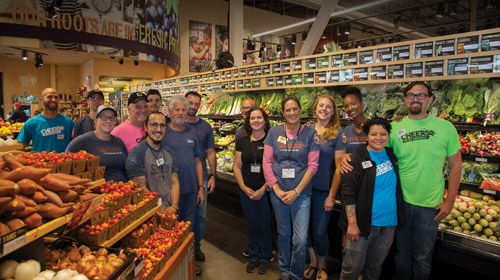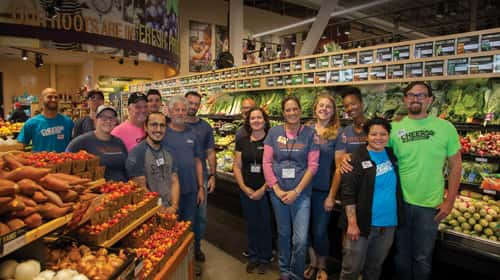
Thirty years ago on a November day, Steve Maass opened the first Oliver’s Market in Sonoma County, in Cotati. Like most successful companies, it started small, with only 13 employees. Growth was slow but steady, and as the grocery store gained a loyal following, it unveiled its second location in 2000, in the former Molsberry Market on Santa Rosa’s Montecito Boulevard. The Stony Point Road Oliver’s in Santa Rosa opened in 2007 in what had been a Ralph’s Market. In 2016, Oliver’s opened its fourth store, in Windsor––the first designed and built for the company.
Maass first entered retailing in 1972, when he founded Maass Produce, operating roadside produce stands around the Bay Area. He later became produce manager at the Santa Rosa Food 4 Less store. “After a couple of years [in that job], I felt I needed a bigger challenge, so I mortgaged my house and, with the support of my parents, bought the Cotati store,” he said in a 2012 NorthBay biz Beyond the Boardroom feature. The building had previously housed a struggling retailer called Farmers Market.
Today, Maass has created friendly and inviting grocery stores with a mix of natural, conventional and specialty products, and he is committed to keeping the focus “local,” which helps to support a wide range of area farmers and makers of food, beverage and wellness products. Oliver’s purchases goods and services from more than 600 Sonoma County companies and vendors that accounts for more than 6,000 individual products, and sells more than $25 million in local products every year.
Last year, Oliver’s Market became a Social Purpose Corporation, making official its purpose to manage the company for the benefit of employees, the community and the environment. Oliver’s also supports numerous local nonprofits through its Community Card program. The card lets shoppers donate a portion of their store purchases to the charity of their choice. In 2017, more than $300,000 was donated to Sonoma County charities through the program.
Rolling out the ESOP
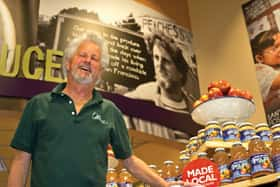 As president of Oliver’s, Maass now oversees a multi-store empire with approximately 1,100 employees. “I feel the success of the business is due to the teamwork of the entire staff. Our employees are what make Oliver’s what it is, and I strive to see them all as individuals and ensure they’re always treated with respect,” Maass once stated during the same interview.
As president of Oliver’s, Maass now oversees a multi-store empire with approximately 1,100 employees. “I feel the success of the business is due to the teamwork of the entire staff. Our employees are what make Oliver’s what it is, and I strive to see them all as individuals and ensure they’re always treated with respect,” Maass once stated during the same interview.
“We’re really in the customer service business,” he remarked recently. “Our labor is much higher than a place like Safeway. We all know each other here to some degree, and we are more family oriented.”
His commitment to finding and keeping valued employees is still foremost in his plans for the future of the company. That’s why Maass implemented an Employee Stock Ownership Plan (ESOP) last year for Oliver’s employees to jointly purchase 43 percent of the company over the next few years.
“A lot of larger corporations have tried to buy Oliver’s, and many of them made generous offers, but it seems every successful company eventually sells out. Instead, we want to keep this company locally owned, if at all possible,” says Maass. “The leadership team at Oliver’s has been working together for more than 20 years, and we all feel the same about keeping the company local.”
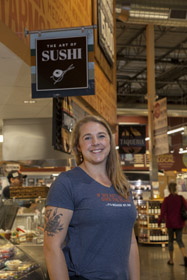 The ESOP officially began on January 1, 2017, but talk of setting up the program was discussed as early as 2014. “The first conversations I heard about it were four years ago,” says Aubrey Ballinger, a six-year Oliver’s employee who works in the company’s graphics and marketing department. “At that point, we knew Steve was going to sell the company to the employees, but we didn’t know exactly what that meant.”
The ESOP officially began on January 1, 2017, but talk of setting up the program was discussed as early as 2014. “The first conversations I heard about it were four years ago,” says Aubrey Ballinger, a six-year Oliver’s employee who works in the company’s graphics and marketing department. “At that point, we knew Steve was going to sell the company to the employees, but we didn’t know exactly what that meant.”
As Maass explains it, the ESOP is a great retirement plan for employees, in addition to their 401(k)s. “It’s basically a retirement plan, but the employees don’t have to pay any federal or state taxes on the 43 percent they own of the stores. So, as they gain equity, whatever profits Oliver’s makes, 43 percent goes to the employees outright. Eventually, I’ll sell them the remaining portion of the company.”
In essence, he adds, the ESOP is a succession plan. “My daughter isn’t interested in taking over the business, so it’s a great option for the people who have helped build this company. I’ve worked with many of these people for 20 to 25 years and we’re like family. Nobody does this all by themselves.”
Vesting and eligibility
Of the 1,100 employees, approximately 670 meet the eligibility criteria for the ESOP: they must be at least 21 years old and work a minimum of 1,000 hours in a calendar year. “Under these guidelines, many of our part-time workers don’t qualify,” says Maass. “For instance, we employ many grocery baggers who are younger than 21, and also students in their first jobs who don’t work enough hours.”
Establishing an ESOP is much more difficult to implement and roll out than most people might think, says Maass. “It’s an expensive proposition. We work with an independent evaluator, and everything about the process has a third-party link. We need to employ several people to handle all that, including the evaluation firms, a lawyer and accountants. It’s complicated to get it established, but if you want your company to remain locally owned, it’s one good way you can do that.” (See “ESOPs Explained”.)
With adoption of the ESOP, Oliver’s becomes the largest employee-owned company in Sonoma County based on eligible workers. The vesting program gives employees with more than 10 years of service full vesting in their allocated shares immediately, and all eligible employees hired at the start of the program on January 1, 2017, will be fully vested in three years. The first ESOP statements were presented to employees in late September following a lengthy reporting and auditing process of approximately 18 months.
Ballinger is chair of the company’s ESOP communications committee, tasked with being the liaison between employees and the ESOP trustee committee. “We meet every six to eight weeks to bring together ESOP communications committee members in each of the four stores and also our business office. Our role is to effectively communicate to employees what the ESOP means, not only for the good of the company, but also for them individually.”
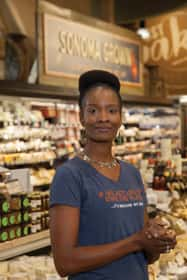 Also a member of the ESOP communications committee, Devorah Harris joined Oliver’s more than four years ago, working in the gourmet cheese department in the company’s Cotati store. She admits being initially hesitant to sign up for the investment program, but ultimately realized it was a smart move.
Also a member of the ESOP communications committee, Devorah Harris joined Oliver’s more than four years ago, working in the gourmet cheese department in the company’s Cotati store. She admits being initially hesitant to sign up for the investment program, but ultimately realized it was a smart move.
“This is a way for employees to take more ownership and pride in our company. We were even issued T-shirts that said, ‘If I act like I own the place, it’s because I do.’ It’s important to keep our local market local, and the best way to do that is to help give some of it back to the employees. It’s definitely the right step. It’s investing a certain amount of my own money into my retirement. I can’t use it right now, but it’s helping me to prepare for my future.
“As it was explained to us, it’s not a get-rich-quick scheme. So, keeping that in mind, knowing the outcome, I’ll have something in the end as long as the company grows and remains profitable. As I get older, I’ll be looking at more ways I can put money away for the future.”
Harris was born and raised in Santa Rosa, and Oliver’s was her late mother’s favorite place to shop, she says. “Being able to work here has been healing for me.”
Educating employees
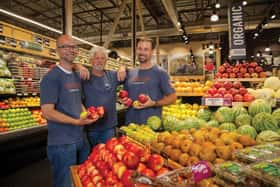 The trustee for the Oliver’s Market ESOP is Eric Meuse, a co-general manager who’s been with the company for 29 of its 30 years. After first hiring a trustee who lived in a neighboring county, Maass felt that person wasn’t able to provide the personal contact he’d hoped for, says Meuse.
The trustee for the Oliver’s Market ESOP is Eric Meuse, a co-general manager who’s been with the company for 29 of its 30 years. After first hiring a trustee who lived in a neighboring county, Maass felt that person wasn’t able to provide the personal contact he’d hoped for, says Meuse.
“That’s when Steve asked if I would take over the role,” he explains. “We felt it was better to use an internal trustee, so now the ESOP trustee committee includes myself, our grocery buyer, Lawrence Jacobs, and our Chief Financial Officer Jill Olsen. We’ve all been with Oliver’s for 25-plus years. We have to make decisions based on what we believe to be in the best interest of the ESOP, not necessarily of the company. Precise paperwork is also important. We’ve attended several conferences about ESOPs, and they all stressed that we must dot all our I’s and cross all our T’s.”
Meuse says his primary responsibility as ESOP trustee is to approve share values after evaluation by a third-party company. “The trustee contracts with the evaluator to do a thorough assessment of the company and place a value on it. The trustee committee reads over the draft evaluations, meets with CPAs, and conducts phone interviews with the evaluation company. We also use an attorney who specializes in ESOPs. The third-party administrator determines how much money will be allocated. They do all the math and issue the statements to employees.”
Early feedback from employees about the ESOP was all over the board, says Meuse. “Some asked when they would get their money, or if it meant they would get their groceries free. We promote the ESOP as an ownership culture. What the employees own is the rights to the shares that have a dollar value. It’s been tricky at times to get the employees to understand it, but most are excited about what the future may bring.”
Regular communications
The company initially launched an extensive education campaign to explain the ESOP to employees, and is continually getting the word out. “As I interact with store liaisons, we’re working to find creative ways to help employees understand all the nuances of the program,” says Ballinger. “There are many components to it, so we assist them in understanding how they are invested in it and how it is set up to help them to succeed.”
Communication about the ESOP began with flyers and emails in the early stages, together with meetings with Human Resources staff. “Recently we’ve done posters that are simple, informative and eye-catching,” says Meuse. “We are keeping the ESOP in regular conversations at our weekly management meetings and as we engage with employees.”
“When employees see how it works and the many benefits to it, being in the ESOP can help them become more engaged in their work, and seeing how they make a difference, and how it will benefit them in the long run,” says Ballinger. “It’s a big change and a good change.”
ESOPs Explained
There are several ways through which employees can become the owners of their company, but an Employee Stock Ownership Plan (ESOP) is the main source of employee ownership in the United States, according to the Oakland-based National Center for Employee Ownership.
An ESOP is a type of employee benefit plan where the ESOP trust acquires company stock and holds it in accounts for employees. Many people have misconceptions about ESOPs, thinking, for example, that employees buy the stock, or that an ESOP works like an equity compensation plan. An ESOP enables employees to own part or all of the company where they work. Individual employees accumulate shares in their retirement accounts over time, and they cash in those shares when they retire or leave. Yet the stock they own never costs them a dime.
The first step is to set up an ESOP trust, which is a legal entity that will hold shares of stock on behalf of the employees. It’s governed by many of the same rules as 401(k) plans, but is funded entirely by the company. The company contributes money to the trust, or else the trust borrows money from a bank, the seller, or both. If it borrows the money, as is common, the arrangement is called a leveraged ESOP. Using that money, the trust buys some or all of the company’s shares from the owner or owners. An independent appraiser determines the price of the shares.
Then, the trust begins allocating shares to the retirement accounts of employees. By law, shares must be distributed according to relative pay or by some formula that results in a more equal distribution. The eligible employees’ accounts now have stock and they are the owners, without having made any cash outlay.
When employees leave the company, they are cashed out on various schedules depending on their account details, and the ESOP may provide them with a significant retirement benefit. Beyond individual employees, the ESOP protects jobs by providing ownership continuity and keeping the company as a going concern.
30 Years of Growth and Buying Power
1988: The company is founded by Steve Maass with the opening of the first store in Cotati. Maass had run produce stands across the Bay Area and wanted to create a store where customers would truly enjoy shopping.
1994: The Cotati store is expanded from 25,000 square feet to 36,000 square feet. The “Oliver’s Mix” of fresh and local products, natural and bulk foods, gourmet and ready-to-eat foods, and core general grocery items is created.
2000: The Montecito store opens in Santa Rosa in the former Molsberry Market space.
2007: The Stony Point Santa Rosa store opens in the former Ralph’s Market space. Oliver’s Market launches the Community Card program, which directs a portion of customers’ purchases to the local nonprofit organizations of their choice.
2009: Oliver’s joins GO LOCAL Sonoma County, a network of locally-owned businesses, residents, nonprofit organizations, and government agencies working together to build a resilient, thriving, local economy by supporting local, independently-owned businesses and promoting sustainable practices.
2010: Oliver’s commissions a Sonoma State University economic study conducted by Robert Eyler, M.D., showing that buying groceries at a locally-based business focused on locally-made products results in 40 percent more tax revenue going back to the community. For every Oliver’s job, there is 6/10 of a job at a local partner as a result.
2012: Responding to rising health care costs and employee needs, Oliver’s creates a self-funded health insurance program so that every eligible employee has coverage.
2013: Oliver’s adds offices and a distribution center to its operations, purchasing a warehouse in northern Santa Rosa.
2015: Oliver’s breaks ground on its fourth store, in Windsor. This is the grocer’s first store designed and built specifically for the company. Oliver’s commissions an update on the 2010 economic study, which confirms the power of local purchases.
2016: The Windsor store opens in May, featuring the Tavern Off The Green, a casual pub serving local beer, wine and cider.
2017: Oliver’s wins the Progressive Grocer 2017 Outstanding Independent Award in the multi-store category. Oliver’s owner Steve Maass sells a portion of the company to employees through an Employee Stock Ownership Plan (ESOP).
2018: Oliver’s celebrates its 30th anniversary serving Sonoma County.
Author
-

Jean Doppenberg is a lifelong journalist and the author of three guidebooks to Wine Country.
View all posts


